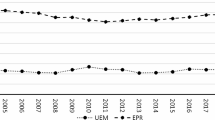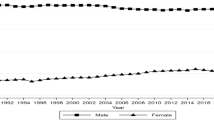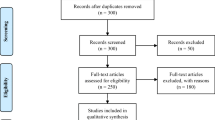Abstract
Population aging is expected to challenge many developed and emerging countries in the coming years. Occupational accidents (OA) and their relationship with population aging have become issues of interest in these countries. This study proposes a theoretical macroeconomic model to investigate the impact of factors influencing OA based on a labor supply theoretical framework. An autoregressive distributed lag-bounds testing approach was employed to empirically estimate the proposed model using data from Japan from 1961 to 2019. The results confirmed the positive impacts of aging labor and average working hours on OA. On the other hand, investment in industrial accident prevention measures significantly reduced OA. The results shed light on the effects of population aging on the labor market and provide practical policy recommendations.

Source: Authors, data extracted from World Development Indicators Data Bank

Source: Authors, data extracted from World Development Indicators Data Bank

Source: www.mhlw.go.jp, 2018)

Source: Data for OA extracted from JISHA (2020) and GDP per capita from the World Bank website

Source: Data for OA extracted from JISHA (JISHA) and new capital stock from Penn World Tables, version 10.0

Source: JISHA (JISHA)

Source: JISHA (JISHA)

Source: Authors' calculation from Eviews 12.0

Source: Authors' calculation from Eviews 12.0
Similar content being viewed by others
Data availability
The data that support the findings of this study are available from the corresponding author upon reasonable request.
Notes
More details on these plans can be found on the website: (www.mhlw.go.jp, 2018).
https://www.toshiba.co.jp/. Seen in July 2020.
References
Adnett N, Dawson A (1998) The economic analysis of industrial accidents: a re-assessment. Int Rev Appl Econ 12(2):241–255. https://doi.org/10.1080/02692179800000005
Amagasa T, Nakayama T, Takahashi Y (2005) Karojisatsu in Japan: characteristics of 22 cases of work-related suicide. J Occup Health 47:157–164
Barth A, Winker R, Ponocny-Seliger E, Sögner L (2007) Economic growth and the incidence of occupational injuries in Austria. Wien Klin Wochenschr 119(5–6):158–163. https://doi.org/10.1007/s00508-006-0726-7
Bravo G, Castellucci HI, Lavallière M, Arezes PM, Martinez G (2022) The influence of age on fatal work accidents and lost days in Chile between 2015 and 2019. Saf Sci 147:105599. https://doi.org/10.1016/j.ssci.2021.105599
Chen C, Reniers G, Khakzad N, Yang M (2021) Operational safety economics: foundations, current approaches and paths for future research. Saf Sci 141:105326. https://doi.org/10.1016/J.SSCI.2021.105326
Cirakly U, Yildirim HH (2019) The impacts of economic crisis on the public health in Turkey: an ARDL bounds testing approach. Hacettepe Sağlık İdaresi Dergisi 22(2):259–280
Çolak O, Palaz S (2017) The relationship between economic development and fatal occupational accidents: evidence from Turkey. Sci Ann Econ Bus 64(1):19–31. https://doi.org/10.1515/saeb-2017-0002
Dong XS, Wang X, Daw C (2012) Fatal falls among older construction workers. Hum Factors 54(3):303–315. https://doi.org/10.1177/0018720811410057
Engle RF, Granger CWJ (1987) Co-integration and error correction: representation, estimation, and testing. Econometrica 55(2):251–276. https://doi.org/10.2307/1913236
Gao Y, Hao Y, Wang S, Wu H (2021) The dynamics between voluntary safety reporting and commercial aviation accidents. Saf Sci 141:105351. https://doi.org/10.1016/j.ssci.2021.105351
Haruyama Y, Matsuzuki H, Tomita S, Muto T, Haratani T, Muto S, Ito A (2014) Burn and cut injuries related to job stress among kitchen workers in Japan. Ind Health 52(2):113–120. https://doi.org/10.2486/indhealth.2013-0143
Higashi T (2009) Trends and issues of occupational safety and Health in Japan–Health and safety measures in response to globalization, diversification of employment formats, and declining birth rates, The Institute of Industrial Ecological Sciences, University of Occupational and Environmental Health, Japan. https://www.bollettinoadapt.it/old/files/document/6697HIGASHI_EU_03_20.pdf
Honda A, Date Y, Abe Y, Aoyagi K, Honda S (2014) Work-related stress, caregiver role, and depressive symptoms among Japanese workers. Saf Health Work 5(1):7–12. https://doi.org/10.1016/j.shaw.2013.11.002
Hori M (2012) The trend and issues of occupational safety and health in Japan. Procedia Eng 43:610–614. https://doi.org/10.1016/j.proeng.2012.08.107
Horie S (2010) Occupational health policies on risk assessment in Japan. Saf Health Work 1(1):19–28. https://doi.org/10.5491/SHAW.2010.1.1.19
Horie S (2013) History of occupational health physician and industrial safety and health law. J UOEH 35(Supplement):1–26. https://doi.org/10.7888/juoeh.35.suppl1_1
Iqbal J (2011) Forecasting performance of alternative error correction models, Munich Personal RePEc Archive, Paper No. 29286
Iqbal J, Uddin MN (2013) Forecasting accuracy of error correction models: international evidence for monetary aggregate M2. J Int Glob Econ Stud 6(1):14–32
Ivascu L, Sarfraz M, Mohsin M, Naseem S, Ozturk I (2021) The causes of occupational accidents and injuries in Romanian firms: an application of the Johansen co-integration and Granger causality test. Int J Environ Res Public Health 18(14):7634. https://doi.org/10.3390/ijerph18147634
Iwasaki K, Takahashi M, Nakata A (2006) Health problems due to long working hours in Japan: working hours, workers’ compensation (Karoshi), and preventive measures. Ind Health 44(4):537–540. https://doi.org/10.2486/indhealth.44.537
JISHA (2020) https://www.JISHA.or.jp/
Johansen S (1988) Statistical analysis of co-integration vectors. J Econ Dyn Control 12(2–3):231–254. https://doi.org/10.1016/0165-1889(88)90041-3
Kim DK, Park S (2020) Business cycle and occupational accidents in Korea. Saf Health Work 11(3):314–321
Kumar Narayan P, Smyth R (2006) Higher education, real income and real investment in China: evidence from granger causality tests. Educ Econ 14(1):107–125. https://doi.org/10.1080/09645290500481931
Li X, Liu J, Zhou J, Liu X, Zhou L, Wei W (2020) The effects of macroeconomic factors on road traffic safety: a study based on the ARDL-ECM model. Sustainability 12(24):10262. https://doi.org/10.3390/su122410262
Lilley R, Jaye C, Davie G, Keeling S, Waters D, Egan R (2018) Age-related patterns in work-related injury claims from older New Zealanders, 2009–2013: implications of injury for an aging workforce. Accid Anal Prev 110:86–92. https://doi.org/10.1016/j.aap.2017.10.022
Lin CJ, Chang HM, Hung CJ (2020) The impact of low fertility in East Asia: a case study of low fertility crisis management in Japan. Asian J Educ Soc Stud 6:11–18. https://doi.org/10.9734/ajess/2020/v6i130165
Matsunaga M (2019) Tourism policy in the era of population decline. Toyo University Graduate School Bulletin, No. 56, pp 1–13 (in Japanese)
Narayan PK (2005) The saving and investment nexus for China: evidence from co-integration tests. Appl Econ 37(17):1979–1990. https://doi.org/10.1080/00036840500278103
Niimi Y (2017) The burden of elderly care on families-current situation and issues. Perspect. East Asia 28(1):11–23 (in Japanese)
Nyoni T, Mose N, Thomi J (2021) International tourism and economic growth in Zimbabwe: an ARDL-bounds testing approach. Asian J Econ Bus Acc. https://doi.org/10.9734/ajeba/2021/v21i630392
Oi WY (1974) On the economics of industrial safety. Law Contemp Probl 38(4):669–699. https://doi.org/10.2307/1190974
Pesaran MH, Shin Y (1995) An autoregressive distributed lag modelling approach to co-integration analysis, vol 9514. Department of Applied Economics, University of Cambridge, Cambridge, UK
Pesaran MH, Shin Y, Smith RJ (2001) Bounds testing approaches to the analysis of level relationships. J Appl Econ 16(3):289–326. https://doi.org/10.1002/jae.616
Ruhm CJ (2000) Are recessions good for your health? Q J Econ 115(2):617–650. https://doi.org/10.1162/003355300554872
Saari J (1982) Long-term development of occupational accidents in Finland. Scand J Work Environ Health Health 8(2):85–93. https://doi.org/10.5271/sjweh.2484
Saitou S (2011) Sangyou anzen undou 100 nen no rekishi. Youboujihou 244:14–21
Schwatka NV, Butler LM, Rosecrance JR (2012) An aging workforce and injury in the construction industry. Epidemiol Rev 34(1):156–167. https://doi.org/10.1093/epirev/mxr020
Song L, He X, Li C (2011) Longitudinal relationship between economic development and occupational accidents in China. Accid Anal Prev 43(1):82–86. https://doi.org/10.1016/j.aap.2010.07.014
Spengler JJ (1968) The economics of safety. Law Contemp Probs 33(3):619. https://doi.org/10.2307/1190944
Thaler R, Rosen S (1976) The value of saving a life: evidence from the labor market. In: Terleckyj NE (ed) Household production and consumption. National Bureau for Economic Research, pp 265–302
Topbas F (2015) Economic cost of work accidents: Granger causality analysis on Turkey with a panel data approach. Asian J Appl Sci 3(2):255–259
Tsukada T, Sakakibara H (2016) Risk assessment of fall-related occupational accidents in the workplace. J Occup Health 58(6):612–621. https://doi.org/10.1539/joh.16-0055-OA
Uddin GS, Alam MM, Murad W (2011) An empirical study on income and energy consumption in Bangladesh. Energy Stud Rev. https://doi.org/10.15173/esr.v18i1.529
Uddin GS, Sjö B, Shahbaz M (2013) The causal nexus between financial development and economic growth in Kenya. Econ Modell 35:701–707. https://doi.org/10.1016/j.econmod.2013.08.031
Vedd R, Yassinski N (2014) The relationship between national income and occupational injury. Adv Res 2(12):906–917. https://doi.org/10.9734/AIR/2014/11157
Acknowledgements
Farhad Taghizadeh-Hesary acknowledges the financial support from the Grant-in-Aid for the Excellent Young Researcher of the Ministry of Education, Culture, Sports, Science and Technology of Japan (MEXT); Grant-in-Aid for Young Scientists (No. 22K13432) of the Japan Society for the Promotion of Science (JSPS) and the Grant-in-Aid for Scientific Research (B) (No. 22H03816) of the JSPS. Certainly, all remaining errors are our own.
Author information
Authors and Affiliations
Corresponding authors
Ethics declarations
Conflict of interest
No potential conflict of interest was reported by the authors.
Additional information
Publisher's Note
Springer Nature remains neutral with regard to jurisdictional claims in published maps and institutional affiliations.
Rights and permissions
Springer Nature or its licensor (e.g. a society or other partner) holds exclusive rights to this article under a publishing agreement with the author(s) or other rightsholder(s); author self-archiving of the accepted manuscript version of this article is solely governed by the terms of such publishing agreement and applicable law.
About this article
Cite this article
Pourrostami, N., Taghizadeh-Hesary, F. & Zarezadeh Mehrizi, F. Population aging and working hour impacts on occupational accidents: evidence from Japan. Econ Change Restruct 56, 2621–2644 (2023). https://doi.org/10.1007/s10644-023-09526-4
Received:
Accepted:
Published:
Issue Date:
DOI: https://doi.org/10.1007/s10644-023-09526-4




